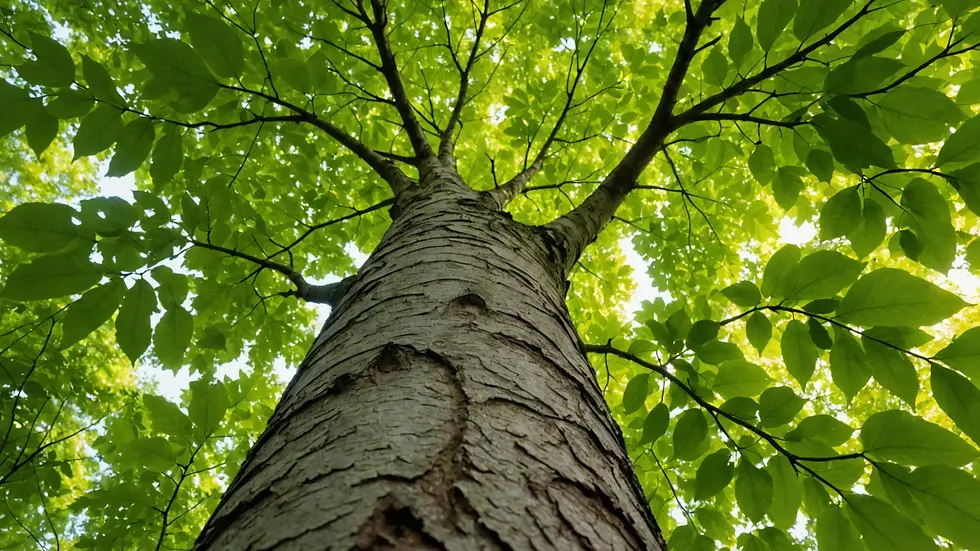The American Beech: A Unique and Iconic Species to Identify and Appreciate in North America
- arundeltree
- Feb 5
- 4 min read
The American Beech (Fagus grandifolia) is a majestic and distinctive tree that captivates the hearts and minds of nature enthusiasts across North America. With its smooth, gray bark and unique leaf structure, this species is easily recognized and appreciated for its beauty and ecological significance. In this blog post, we will explore the characteristics, habitat, and importance of the American Beech, and how it interplays with its surrounding environment.
Characteristics of the American Beech
One of the standout features of the American Beech is its bark, which ranges from smooth gray to an almost blue-gray hue. This unique coloration is particularly striking when compared to the rugged textures of nearby oaks and pines.
As the tree ages, the bark tends to darken and may develop cankers or a molten appearance, adding to its character.

The leaves of the American Beech contribute to its distinctive profile. The leaves are coarsely toothed, simple in shape, either ovate or elliptic, and exhibit a lustrous dark green color on their upper surfaces. The lower surfaces showcase a paler, hairy texture.
In autumn, the foliage undergoes a beautiful transformation, shifting from green to shades of yellow and brown, eventually resting on the ground to make way for new growth in the spring.
Habitat and Distribution
Native to North America, the American Beech thrives in rich woodlands, moist slopes, and deciduous forests. It is found from New Brunswick and Ontario in the North to Texas and Florida in the South, typically growing at elevations ranging from 0 to 1250 meters.
The best specimens are believed to flourish in the Ohio and Mississippi River Valleys, where conditions are optimal for growth.

With the right location and ideal growing conditions, the tree can reach impressive heights of nearly 100 feet. It tends to grow in a single erect trunk, crowned by a broad, open canopy that provides ample shade below.
The American Beech is also known to form expansive root systems, which help stabilize the soil and prevent erosion in its native habitats.
Reproductive Features
The American Beech showcases subtle yet interesting reproductive features. Its flowers are diminutive; male flowers cluster in a globular head at the end of silky stalks, while the female flowers are less conspicuous, usually appearing singly or in pairs.
The fruit produced is a unique bristly capsule divided into four compartments. Typically, each capsule contains two angular or ridged nuts, although you may occasionally find one or three.
This fruit is not only a food source for wildlife but also plays a crucial role in the regeneration of the species as the nuts germinate and give rise to new trees.
Ecological Significance
The American Beech plays a significant role in its ecosystem, offering habitat and food for a variety of wildlife. Birds, deer, squirrels, and several other animals are known to feed on the nuts produced by this tree.
In addition to providing sustenance, the dense canopy of the American Beech serves as a shelter for various bird species and other woodland creatures, promoting biodiversity in its habitat.
Moreover, the American Beech interacts harmoniously with its surrounding flora. The tree is known to support a diverse range of plant species through its leaf litter, which enriches the soil and creates a nurturing atmosphere for seedlings.
Cultivation and Uses
Due to its remarkable characteristics, the American Beech is popular among gardeners and landscape designers alike. It is readily available at many nurseries within hardiness zones 4-9, making it accessible for planting in various landscapes.
When planted in residential areas, the American Beech serves not only as an ornamental feature but also provides shade and beauty throughout the seasons. Its impressive height and broad crown make it an excellent choice for creating a focal point in larger gardens or parks.
Moreover, the wood derived from the American Beech is valued for its strength and durability. It is utilized in furniture making and flooring, as well as for various woodworking projects.
Challenges and Conservation
Despite its majestic presence, the American Beech faces several challenges, particularly from disease and climate change. The invasive beech bark disease, caused by a scale insect and a fungal pathogen, poses significant threats to many populations of this tree across its range.
Conservation efforts are underway to protect the American Beech and its ecosystem. Awareness about the importance of preserving healthy woodlands and controlling invasive species is crucial for the survival of this iconic species.
Administrative bodies and local conservation groups work hand in hand to monitor the health of existing beech populations and implement strategies to mitigate the impact of threats.
Conclusion
The American Beech (Fagus grandifolia) stands out among North America's trees, not just for its striking appearance but also for its ecological contributions and significance.
As a recognizable species with smooth gray bark, coarsely toothed leaves, and elongated torpedo-shaped buds, it invites everyone to appreciate its beauty and the important role it plays in its habitat.
Whether you encounter a lone American Beech in the woods or admire a grove in a public park, take a moment to recognize the uniqueness of this iconic tree and consider the part you can play in preserving its legacy for future generations.
With ongoing conservation efforts and increased awareness, the future of the American Beech remains hopeful, allowing it to thrive and continue enriching the landscapes of North America.





Comments